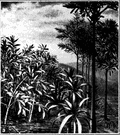pa·le·o·bot·a·ny
(pā′lē-ō-bŏt′n-ē)n.
The branch of paleontology that deals with plant fossils and ancient vegetation.
pa′le·o·bo·tan′ic (-bə-tăn′ĭk), pa′le·o·bo·tan′i·cal (-ĭ-kəl) adj.
pa′le·o·bo·tan′i·cal·ly adv.
pa′le·o·bot′a·nist n.
American Heritage® Dictionary of the English Language, Fifth Edition. Copyright © 2016 by Houghton Mifflin Harcourt Publishing Company. Published by Houghton Mifflin Harcourt Publishing Company. All rights reserved.
paleobotany
(ˌpælɪəʊˈbɒtənɪ)n
(Palaeontology) a variant spelling of palaeobotany
Collins English Dictionary – Complete and Unabridged, 12th Edition 2014 © HarperCollins Publishers 1991, 1994, 1998, 2000, 2003, 2006, 2007, 2009, 2011, 2014
pa•le•o•bot•a•ny
(ˌpeɪ li oʊˈbɒt n i; esp. Brit. ˌpæl i-)n.
the branch of paleontology that deals with fossil plants.
[1870–75]
pa`le•o•bo•tan′i•cal (-bəˈtæn ɪ kəl) pa`le•o•bo•tan′ic, adj.
pa`le•o•bot′a•nist, n.
Random House Kernerman Webster's College Dictionary, © 2010 K Dictionaries Ltd. Copyright 2005, 1997, 1991 by Random House, Inc. All rights reserved.
paleobotany, palaeobotany
the branch of paleology that studies fossil plants, especially their origin, structure, and growth. — paleobotanist, palaeobotanist, n. — paleobotanic, palaeobotanic, paleobotanical, palaeobotanical, adj.
See also: Fossils-Ologies & -Isms. Copyright 2008 The Gale Group, Inc. All rights reserved.
ThesaurusAntonymsRelated WordsSynonymsLegend:
| Noun | 1. |  paleobotany - the study of fossil plants paleobotany - the study of fossil plants palaeodendrology, paleodendrology - the branch of paleobotany that studies fossil trees palaeobiology, paleobiology - a branch of paleontology that deals with the origin and growth and structure of fossil animals and plants as living organisms |
Based on WordNet 3.0, Farlex clipart collection. © 2003-2012 Princeton University, Farlex Inc.